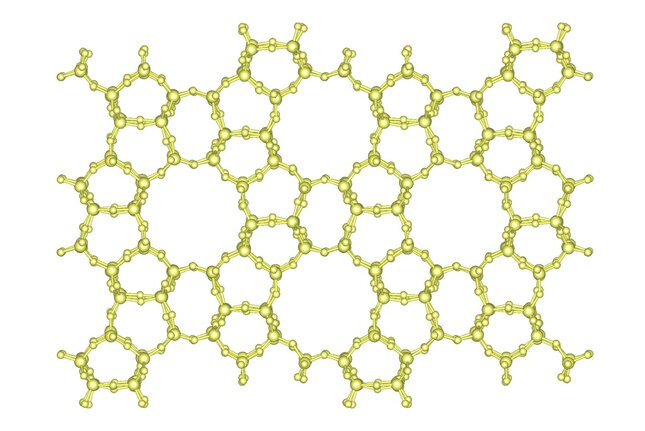Synthesizing nanosized zeolites
Shaojie Li defended his PhD-thesis at the department of Chemical Engineering & Chemistry on September 8, 2022

Zeolites are crystalline inorganic materials whose oxide-based framework is built with corner-sharing TO4 tetrahedrons, where T refers to a tetrahedral atom, most commonly Si and Al. Thanks to their well-defined structure and tunable material properties, zeolites are frequently used as catalysts in all kinds of applications, from industrial processes to household products such as water softeners in detergent. For his PhD research, Shaojie Li developed new and cost-effective ways to synthesize nano-sized zeolites.

Zeolites are widely used in industrial processes, especially in ion-exchange, adsorption/separation, and catalysis areas, and they are one of the most widely used classes of materials among the heterogeneous catalysts. They are useful catalysts because of their tunable acidity, (hydro)thermal stability and shape selectivity. Zeolites form with many different crystalline structures, which have large open pores (sometimes referred to as cavities) in a very regular arrangement and roughly the same size as small molecules.
The performance of zeolite catalysts is often hampered by the long residence times of reactants and products in the micropore network. Nanosizing zeolite crystal domains to less than 100 nm can effectively improve diffusion and reduce the residence time of guest molecules in zeolites. In his PhD research, Shaojie Li developed the use of easily accessible non-surfactant diquaternary ammonium compounds for the direct synthesis of nanosized zeolites of particular topologies and acidity in order to optimize the catalytic performance.
“The common process now used in the industry is the post-treatment approach via desilication and dealumination. Compared to the post-treatment approach, my process provides more flexibility in the preparation of nanosized zeolites. Besides, there is more control over the physicochemical properties of the obtained zeolites in my direct synthesis process. Although it still requires further development to make my synthesis process commercial, these obtained well-defined nanosized zeolites in my work are already promising candidates for fundamental studies, e.g. to study the impact of diffusion length on the catalytic performance in a systematic manner”, say Li.
Strategies to synthesize zeolites
Generally, the strategies can be divided into top-down and bottom-up approaches, based on whether nanocrystals are obtained after or during zeolite crystallization, respectively. Compared to top-down approaches, e.g. ball-milling and delamination, bottom-up methods provide more flexibility in the preparation of nanocrystalline zeolites.
Since the number of nuclei in the system determines the ultimate crystal size, formation of small zeolite crystals requires conditions that favor nucleation over crystal growth. These conditions may include prolonging the aging time, utilization of easily dissolved aluminum and silica sources, addition of seeds, use of ultra-dense gels crystallized by steaming, replacing traditional heating by microwave irradiation and decoupling nucleation from crystal growth via a staged temperature approach.
Although soft-templating methods, as an easier bottom-up approach, have been used to prepare nanocrystalline zeolites, the most commonly used method is the dual-templating method. This involves the combined usage of a template for the formation of zeolite and a soft template, usually a surfactant, for limiting the crystal grain growth.
Desired production process
From the practical and economic perspective, it would be attractive to directly synthesize nanosized zeolites by use of relative simple and inexpensive organic molecules as dual-functional templates. Li says: “In my research, it was our goal to synthesize nanosized zeolites with targeted physicochemical properties for improved or tailored catalytic performance in zeolite-catalyzed hydrocarbon conversion reactions.”
Li developed ways to synthesize zeolite nanocrystals directly by using simple and inexpensive organic molecules, particularly non-surfactant diquaternary ammonium compounds, as the sole organic template. His research highlights how to take advantage of several properties, i.e. rigidity, flexibility, size and shape, of the non-surfactant diquaternary ammonium OSDAs. Additionally, its synergistic effect with the inorganic precursor species was very helpful during the hydrothermal synthesizing of zeolites with targeted physicochemical properties.
Finally, these nanosized zeolites showed improved catalytic performance in industrially important reactions for hydrocarbon processing, such as n-paraffins hydroconversion and methanol-to-hydrocarbons. Li’s research not only made a contribution for synthesis of nanosized zeolites in a cheap and scalable manner, but will also inspire more studies to tackle the ongoing challenge of how to rationally design zeolite synthesis.
More information
Shaojie Li defended his thesis titled Nanosized zeolites directed by easily accessible non-surfactant diquats: synthesis, crystallization mechanism and catalytic applications on September 8th, 2022. He was supervised by Prof.dr.ir. Emiel Hensen and Dr. Nikolay Kosinov.
Latest News


